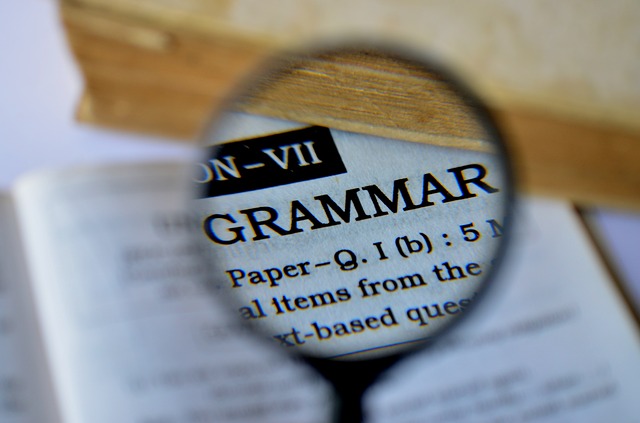Grammar Spotlight
 The English Grammar Profile (EGP) is a sister resource to the English Vocabulary Profile, and has been put together by Anne O'Keeffe (Limerick University) and Geraldine Mark, the co-authors, along with Ron Carter and Mike McCarthy, of English Grammar Today (Cambridge University Press). Mark and O'Keeffe investigated the extensive data in the Cambridge Learner Corpus to establish when learners begin to get to grips with different linguistic structures.
The English Grammar Profile (EGP) is a sister resource to the English Vocabulary Profile, and has been put together by Anne O'Keeffe (Limerick University) and Geraldine Mark, the co-authors, along with Ron Carter and Mike McCarthy, of English Grammar Today (Cambridge University Press). Mark and O'Keeffe investigated the extensive data in the Cambridge Learner Corpus to establish when learners begin to get to grips with different linguistic structures.
A series of insights from their research will be posted on this page, each one putting the spotlight on an interesting aspect of learner grammar development. Please note that all of the learner examples come from the Cambridge Learner Corpus, a 55-million word electronic collection of written learner data. The examination and the candidate’s first language are given in brackets after each learner example.
See the latest Grammar Spotlight entry below. Scroll right down to the bottom of this page to browse through previous entries.
A key addition to learner work at the B2 level is the use of whose. Learners at this level can use non-defining relative clauses with whose in order to give additional information.
 And I was initially employed to be an entrance assistant, whose job was to keep the queue under control as well as keeping the area clean. (Cambridge English: First; Chinese)
And I was initially employed to be an entrance assistant, whose job was to keep the queue under control as well as keeping the area clean. (Cambridge English: First; Chinese)
 I was at the concert when I met a friend of mine whose job is to organise shows like that. (Cambridge English: First; Italian)
I was at the concert when I met a friend of mine whose job is to organise shows like that. (Cambridge English: First; Italian)
They are also able to use defining relative clauses with whose in order to provide more information about relationship.
 I visited several primary schools in Canberra and had opportunities to teach not only Australian children but also Vietnamese children whose parents had immigrated to Australia. (Cambridge English: First; Japanese)
I visited several primary schools in Canberra and had opportunities to teach not only Australian children but also Vietnamese children whose parents had immigrated to Australia. (Cambridge English: First; Japanese)
 Mary is a young lady whose parents had died and she had nobody else but an aunt to live with. (Cambridge English: First; Portuguese)
Mary is a young lady whose parents had died and she had nobody else but an aunt to live with. (Cambridge English: First; Portuguese)
B2 level learners also use defining relative clauses and non-defining relative clauses ending in a preposition, with who, which or that as the complement of the preposition.
 Thank you very much for having provided us with valuable information about your finance services, which we are greatly interested in. (Cambridge English: Business Vantage; Chinese)
Thank you very much for having provided us with valuable information about your finance services, which we are greatly interested in. (Cambridge English: Business Vantage; Chinese)
 I would like to do some painting, which I am quite good at. (Cambridge English: First; French)
I would like to do some painting, which I am quite good at. (Cambridge English: First; French)
 They have three wonderful children who I love to play with. (Cambridge English: First; Swedish)
They have three wonderful children who I love to play with. (Cambridge English: First; Swedish)
B2 level learners can use a relative clause to refer to a whole clause or sentence, often to express an opinion or evaluation or to give a reason.
 It is now possible to send a letter and receive an answer within ten minutes, which is a good thing if you want to buy a house, a car, etc. (Cambridge English: First; Danish)
It is now possible to send a letter and receive an answer within ten minutes, which is a good thing if you want to buy a house, a car, etc. (Cambridge English: First; Danish)
 In addition, zoological gardens allow us to get to know the lifestyles of some animals better, which is very important from the point of view of their protection. (Cambridge English: First; Polish)
In addition, zoological gardens allow us to get to know the lifestyles of some animals better, which is very important from the point of view of their protection. (Cambridge English: First; Polish)
 I have also visited the dance shows and the art exhibitions, as well as the talks by writers, which were all really brilliant. (Cambridge English: First; French)
I have also visited the dance shows and the art exhibitions, as well as the talks by writers, which were all really brilliant. (Cambridge English: First; French)
So, it is at the B2 level when whose is introduced to learner work; learners begin to end clauses in a preposition and learners use relative clauses in giving a reason. These are the final developments in learners’ use of relative clauses. After the B2 level is achieved, there is no significant development in learner use of relative clauses although there remain areas for development. For example, whose, a key word learned at this level, is for learners at the B2, C1 and C2 levels significantly underused when compared to native speakers.






